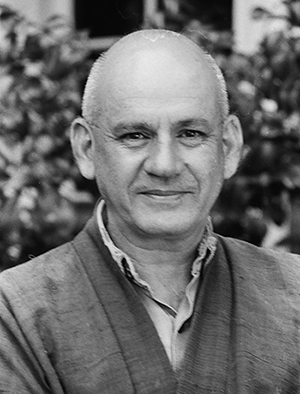
These contributions [see full document—Without Words] were gathered, edited, and arranged by Shosan Victoria Austin, Basya Petnick, and Diane Miller.
Sojun Mel Weitsman (July 9, 1929 – January 7, 2021) was Abbot at San Francisco Zen Center from 1988 to 1996. He emphasized practicing the Dharma with his every action.
People who practiced with him at San Francisco Zen Center while he was abbot during those years (1988 to 1996) were asked:
How did Sojun teach you—without saying a word?
How has this developed in your practice?
How do you practice it today?
For Zen students the answers sometimes couldn’t fit the questions. Each person spoke to the moments that they still carry in their “beyond words” memory.
Excerpts from the full collection
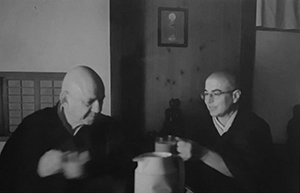
Shosan Victoria Austin
Some of Sojun’s face-to-face teachings:
1975: “Come sit.”
1977: “If you are practicing Buddhism to resolve Judaism, practice Judaism.”
1987: 89 days in a row, bowing with me as Shuso: “No, fold your zagu like this. Like this.” 90th day: “Hmph.”
1993: Bowing to me as Tenzo: “What do you want me to do? How do you want me to do it?”
1999: Bowing to me as Deshi: “The rice is long cooked.”
2009: “Your contribution is priceless. Beyond this book.”
2020: “No. Don’t write my obituary. Write my legacy.”
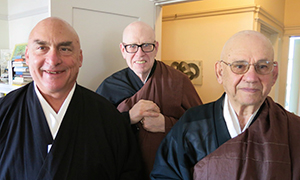
Jusan Edward Brown
In 1995 Sojun and I worked together putting rocks in place at Tassajara. I worked with Sojun. Sojun worked with me. As far as I know, the rocks are still there.
No worker, no boss, no leader, no follower. No hiding, no show, nothing special, exactly so.

Kojun Gil Fronsdal
It was quite touching for me to be at my old teacher’s stepping down … that’s really what’s in my heart, my mind. He was a formative teacher for me, and remains a reference point for me in the Dharma. Part of what I teach when I teach comes from his teaching, and even more, how he lived in the world.
He never related to Zen Center as if there was ever a problem. There were never problems, only some things that needed to be addressed. He would wake up in the morning, and he would not see a problem. He would get up, someone would come to him with a problem to be addressed, and he would address it, and take care of what needed to be taken care of, whether it was washing dishes, or talking about fundraising, or talking about institutional issues of the Zen Center as a whole. He didn’t seem to walk through Zen Center assuming there were problems, rather he lived as if there were something to fully be present for, and meet—to really meet the situation, be present, find your way, do what needed to be done, but without seeing it as a problem, without any sense of hurry, without any sense of crisis, without any sense of hesitation. He would be present, in the middle of all circumstances, as if it was the most ordinary thing in the world to do, and take care of what needed care.
I trusted him implicitly. I had complete trust in him as a person. However, I didn’t always feel aligned with his Dharma, with how he taught. This is a little strange to say to a Zen teacher, but it was in response to him asking me about this. His response was so powerful. We were walking side by side when I told him this. He immediately pivoted in front of me, and brought his hands together like this (clap) and said “And that’s where we’ll meet.” For him, this was a meeting place. Just to meet whatever is there, not make it a problem, but just meet it.
Keido Les Kaye
Mel brought a quiet presence to the practice. Students felt comfortable being with him. His calm demeanor reflected confidence, helping to provide the foundation for Zen practice in its early days in the U.S. He was a perfect successor to his teacher: Suzuki Roshi.
Josho Pat Phelan
What strikes me about Sojun Roshi’s practice is how deeply rooted it is in his presence, his steady presence. Over the years of practicing with him at the City Center and hosting him for his many visits to our zendo in North Carolina, I don’t remember him ever rushing or communicating pressure or worry. He is and has been always right here, in this moment attending to it without any need to rush or worry about what comes next, just taking one thing at a time. His grounded presence never changed with circumstances, or with who he was with, or where he was. It was always clear and clearly right here, rooted in his authentic self.
Sojun Roshi’s practice to be who he is without a persona or added charisma, without needing to change depending on who he is with, has been a strong example for me. Just to be authentic, grounded in deep intention, squarely facing what and who is in front of me is how I try to enact this in my life and in presenting the Dharma.
Dairyu Michael Wenger
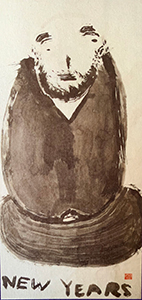
Meetings were always more peaceful when Sojun was present with anything being said. When we were in Japan and Sojun was not wearing robes, he completely blended in. You could not tell what nationality he was.
His teaching … Imperturbability.
Diane Miller
For seven long years I didn’t get Mel’s teaching—the words wandered, lost in some invisible sound barrier. I just sat there, waiting.
Then during the winter of my first practice period at Tassajara, Mel demonstrated the instruments. I finally heard the teaching.
I learned to listen to the true sound hidden behind the words. I learned to listen to what’s unsaid.
My practice is filled with quiet—no need for idle chatter.
Ever present gratitude for the teachings passed from Suzuki Roshi, to you, to Blanche, to me.
Basya Petnick
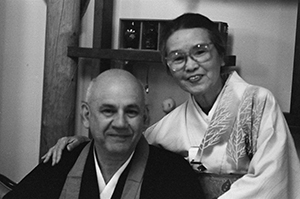
Ordinary Mel is the Way (I have been watching him for many years)
The way he is with short people
The way he is with tall people
The way he is with important people (there aren’t any important people)
The way he is with unimportant people (there aren’t any unimportant people)
The way he is with dogs
The way he with Buddha
The way he is with Dharma
The way he with Sangha
The way he is illness
The way he teaches—open-handed, patient, kind
The way he teaches—close-handed, strict, exacting
The way he shows up for ceremonies
The way he shows up at work meeting
The way he is with Hoitsu
The way he is with Okusan
The way he is with cooking
The way he is with tea
The way he is with lineage
The way he is with text
The way he is with Buddha
The way he with Dharma
The way he is with Sangha
The way he is with breath
FULL DOCUMENT: Without Words
Errata:
Page 8, photo caption: … Idilio Ceniceros receiving his robe from Sojun Mel Weitsman
Page 15, photo caption: Gengetsu Jana Drakka’s Shuso Ceremony … Shinshu Roberts
Addendum: Kyoshin Wendy Lewis
LINKS
An obit for Sojun written by Alan Senauke and shared with Lion’s Roar
Berkeley Zen Center website and Remembering Sojun Roshi
A Tribute to Sojun Roshi: Sojun Mel Weitsman Roshi’s three Green Gulch resident Dharma Heirs—Steve Weintraub, Sara Tashker, and Jiryu Rutschman-Byler—share their reflections on their late teacher’s teaching.
A YouTube photo tribute to Sojun Mel Weitsman created by Barbara Wenger












I definitely appreciate the moments I shared with Mel; his gentle spirit was greatly appreciated.
The way Sojun waited at the door to meet eyes with each of us as we exited the zendo was both unnerving (at first) and later very steadying, almost an affirmation of the zazen we had just sat. Once, after a very deep zazen experience, I approached him and saw the flicker of not-quite-a-smile, but a sort of recognition of where I had been and where I had ended up and what I still carried with me. Over time there were other occasions where I came to recognize in him some deep awareness or sensitivity to Buddhafield, or Dharma presence. Once, in a meeting for new chidens, I was offering encouragement (I thought) and made a crack about how Sojun always tweaked the items on the altar when he was conducting a service. “It’s not that you got it wrong,” I said. “He’s just ‘nesting.'” But later I went up to the altar after he had “tweaked” it, and felt a difference, a kind of force-field or warm living presence in the relations between all the figures whose positions he had adjusted. It made me a believer. There was something to it I was now ready to discover! My chiden practice changed from within without any effort and became something new and nourishing.
Several magical moments in Dokusan will stay with me for life. After years of 50min therapy sessions, I despaired to think of getting something out of a 10 minute Dokusan. But I learned to prepare by finding my question, and then I saw how quickly Sojun flashed on the heart of my dilemma and met me with some simple Zen tale perfectly calibrated to my need. It was a different and more profound “help” than I had ever experienced even from my most helpful therapists.
Sojun was the embodiment of Suzuki Roshi’s teaching; not a day would go by without recollection, without living, Suzuki Roshi’s practice. Then there was Sojun’s life-long editing and publishing Suzuki Roshi’s lectures and the works of Eihei Dogen. And most significantly, because Suzuki Roshi’s life was cut so short, dying in 1971 at age 67, Sojun took on the true teaching and transmitting Suzuki Roshi’s Dharma, which has resulted in his ordaining more than thirty transmitted Dharma heirs and more than 200 lay ordained Zen students, and inspiring countless others, surrounded and supported by the BZC Sangha.
While I was one of those ‘western’ students attracted to Suzuki Roshi in the late 1960’s, I did not begin formal practice until 30 years later following a life-threatening heart failure. Shortly afterward, I ‘walked through the gate’ of Berkeley Zen Center and at a subsequent retreat at Green Gulch, became Sojun’s student. Over the years I served in various positions, formal and informal, at BZC so had the wonderful opportunity to practice and work with Sojun day-to-day. Sojun was very supportive of my relocation up to Sonoma County in 2016 and encouraged continued practice and effort. Asked for advice recently, he said to me, “do and teach what you have been taught, completely”.
In 1967, as a new student at Tassajara, I remember Mel massaging my aching shoulders, from tangaryo. Great generosity of spirit.
Thank you so much, Mel Weitsman.
I never met Mel, but last fall took the online Lion’s Roar series “Zen Mind, Beginner’s Mind,” on the 50th anniversary of the book’s publication. Mel was one of the eight wonderful teachers who presented talks and/or zazen instruction. I listened to his zazen instruction a few days before he died, knowing that it was at the very end of his life. Many of his suggestions stay with me day after day when I sit. And clearest of all is a look he gave the camera just before he signed off at the very end. His face and that friendly look were with me like a teaching, even in zazen this morning.
When asking him whether I should move, he said, “please consider who is moving.” His words continue to reverberate in my awareness.
After reading all the tributes Mel was a true zen master.
I’m a bit over-educated and can be self-demanding. I’ve sat with many teachers, but I learned from no one as much as I did from Mel.
Particularly beneficial was the following exchange during a shosan ceremony at the end of a sesshin at BZC.
I said: “Zen teacher Nanquan states, ‘If you try to approach it, you’ll miss it’ — so what are we to do?”
Mel’s reply helped me: “Don’t try so hard.”
That was it. That was what I needed to hear, and I smiled and I bowed.
And Mel said, “*Like that.*”
I never knew Mel, but knew of him in my time at Zen Center. I think I once went to sit with him at his original attic zendo in Berkeley. When I think of him I always remember a fellow ZC student remarking that Mel was “a real patch-robe monk”. That he was, a good man and a sincere, consistent and diligent disciple of the Dharma. He was a great help to the Zen Center community at a time of trial. I trust he shall find an Auspicious Rebirth.
I only had two meetings with Mel, one 30 years before the other. The first, felt harsh and off putting. So I stayed away, though continuing my daily practice. The second was full of love and joy and celebration. Together we laughed and my wariness melted away. Thank you, Mel.
xo
I only remember Mel in snapshots of time. First, as a visiting abbott to Tassajara, where I met with him just a couple of times in dokusan, and later when he held a service for my stepfather’s passing. I always felt like Mel was above my pay-grade, yet I’m grateful for the chance to experience his twinkling, gentle smile.